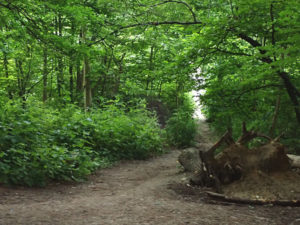 Our precious natural habitats and the wildlife they support are under threat. Habitats are being degraded and damaged by inappropriate use and overuse. Invasive species such as garlic mustard and dog-strangling vine take advantage of disturbed soil and out-compete the plants that have grown here for centuries. Natural areas are crisscrossed by many unauthorized trails that fragment and reduce habitat. The bare compacted soils cannot absorb heavy rains, causing damaging run-off and erosion.
Our precious natural habitats and the wildlife they support are under threat. Habitats are being degraded and damaged by inappropriate use and overuse. Invasive species such as garlic mustard and dog-strangling vine take advantage of disturbed soil and out-compete the plants that have grown here for centuries. Natural areas are crisscrossed by many unauthorized trails that fragment and reduce habitat. The bare compacted soils cannot absorb heavy rains, causing damaging run-off and erosion.
As a result, wildlife big and small, resident and migratory, are negatively impacted by disturbance and habitat loss. All this is happening against a backdrop of intensification, climate change and other broad threats.
“Key impacts that need mitigation include high intensity of recreational use, disturbance by off-leash dogs and free-roaming cats, off-trail activity, encroachment, dumping, introduction and dispersal of invasive species, noise pollution and roads as barriers or hazards to movement of fauna species.” (TRCA report, page 37)
“When biodiversity considerations are integrated into all aspects of city-building, including: land use planning, urban design,transportation, parks and natural heritage management, energy production, waste management and public health, we will begin to realize the potential for more sustainable cities while strengthening their resilience in part by harnessing the ecosystem services that healthy urban biodiversity provides. (Chief Planner Roundtable on Biodiverse TO, May 2017)”
A number of City initiatives recognize the need to protect our natural heritage. The City’s Official Plan was amended in 2015 to designate 68 new Environmentally Significant Areas (ESAs). A Toronto Biodiversity Strategy and Ravine Strategy, as well as management plans for certain Environmentally Significant Areas, are being developed.
While these initiatives are encouraging, there is a disturbing shortage of real protection at the ground level. Our city has a unique opportunity to get it right, before our natural areas reach a tipping point of no return. We believe it’s time to get serious about protecting natural places and wildlife in Toronto.
